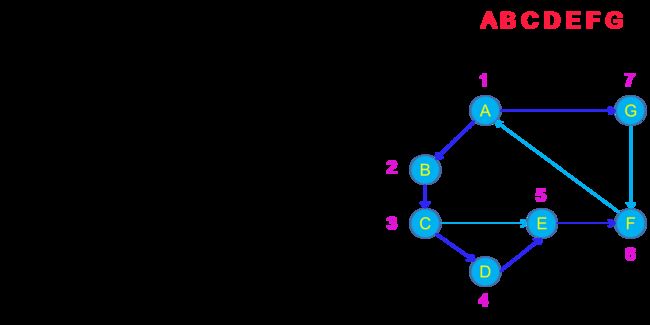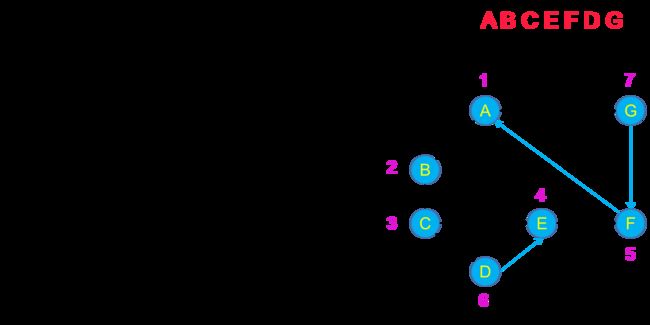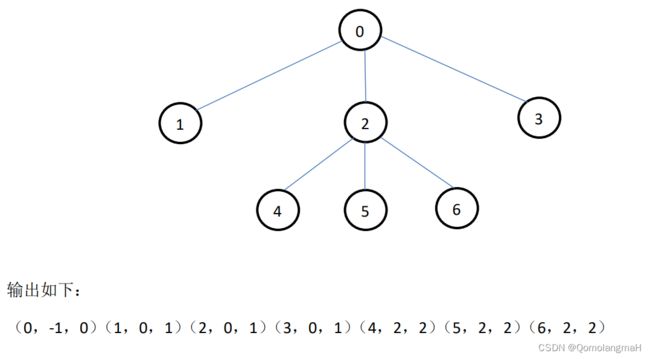【数据结构实验】图(三)图的深度优先搜索(DFS)生成树
文章目录
- 1. 引言
- 2. 深度优先搜索生成树
- 3. 实验内容
-
- 3.1 实验题目
-
- (一)输入要求
- (二)输出要求
- 3.2 算法实现
-
- 1. 数据结构
- 2. 队列操作函数
- 3. 广度优先搜索遍历
- 4. 创建图
- 5. 深度优先搜索算法
- 6. 主函数及DFS主函数
- 7. 输出生成树信息
- 3.3 代码整合
- 4. 实验结果
1. 引言
深度优先搜索(DFS)是图算法中的一种重要的遍历方法,它通过深度遍历图的顶点来构建生成树。生成树是一个无回路的连通子图,包含了原图的所有顶点,但是边数最少。
本实验将通过C语言实现深度优先搜索生成树。
2. 深度优先搜索生成树
深度优先搜索是一种递归的图遍历算法,其主要思想是从起始顶点开始,尽可能深入图中的每一个分支,直到不能再深入为止,然后回溯到上一个分支。



3. 实验内容
3.1 实验题目
以顶点 0 为起始顶点,求图 G 的深度优先搜索生成树(即深度优先遍历过程形成的树)。
(一)输入要求
{0,1,1,1,1,0,0},
{0,0,1,1,0,0,0},
{1,0,0,0,0,0,0},
{0,0,1,0,0,0,0},
{0,0,0,0,0,1,1},
{0,0,0,0,0,0,1},
{0,0,0,0,0,0,0}
使用前文得到的邻接表做为输入数据
(二)输出要求
输出树中所有结点。结点输出格式如下:(顶点,顶点的父亲,顶点所在的层数)比如,对下面这棵树,有以下输出。

3.2 算法实现
1. 数据结构
typedef struct P {
int VerAdj;
struct P *link;
} P;
typedef struct Q {
int VerName;
P *Adjacent;
int Visited;
} Q;
typedef struct {
Q Head[20];
} Graph;
typedef struct Tree {
Q data;
struct Tree *FirstChild;
struct Tree *NextBrother;
} Tree;
typedef struct q {
Tree *data;
struct q *next;
} Queue;
-
P结构体: 用于表示图中的邻接点,
VerAdj表示邻接顶点,link指向下一个邻接点。 -
Q结构体: 用于表示图中的顶点,
VerName表示顶点名称,Adjacent指向邻接点链表,Visited表示是否被访问过。 -
Graph结构体: 表示整个图,包含一个数组
Head,每个元素表示一个顶点。 -
Tree结构体: 表示生成树中的节点,包含一个数据域
data,表示顶点,以及FirstChild和NextBrother分别指向第一个孩子和下一个兄弟节点。 -
Queue结构体: 用于实现队列,存储生成树的节点。
注:自编代码,比较丑陋,请忽略细节
2. 队列操作函数
void QInsert(Tree *item);
void QDelete();
-
QInsert: 将生成树节点插入队列。
-
QDelete: 从队列中删除节点。
3. 广度优先搜索遍历
void LevelOrder(Tree *t);
- LevelOrder: 广度优先搜索遍历生成树,输出节点信息,包括顶点、父亲和层数。
4. 创建图
void Create(Graph *g);
- Create: 根据邻接矩阵
A创建图,构建邻接表。
5. 深度优先搜索算法
void DepthForceSearch(Graph *g, int i, Tree *t);
- DepthForceSearch: 递归实现深度优先搜索,构建生成树。
6. 主函数及DFS主函数
int main();
void DFS_Main(Graph *g, Tree *t);
-
main函数: 创建图,调用DFS_Main进行深度优先搜索,输出生成树的节点信息。
-
DFS_Main: 遍历所有未访问的顶点,以每个未访问的顶点为根进行深度优先搜索。
7. 输出生成树信息
void Output(Tree *t);
- Output: 输出生成树的节点信息。
3.3 代码整合
#include 